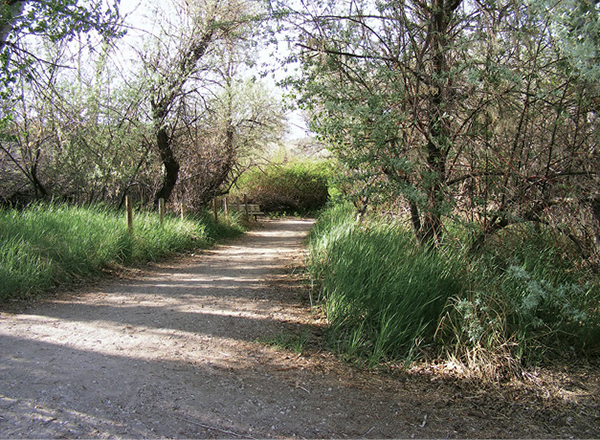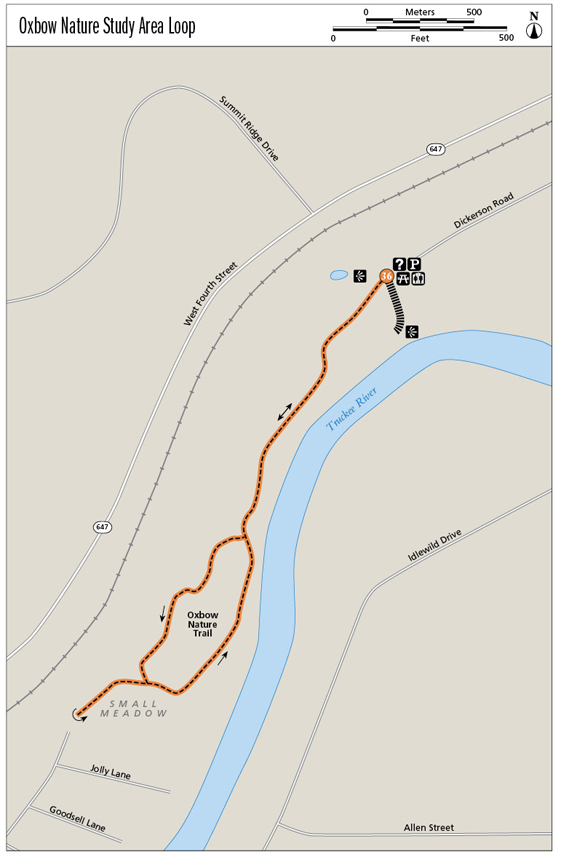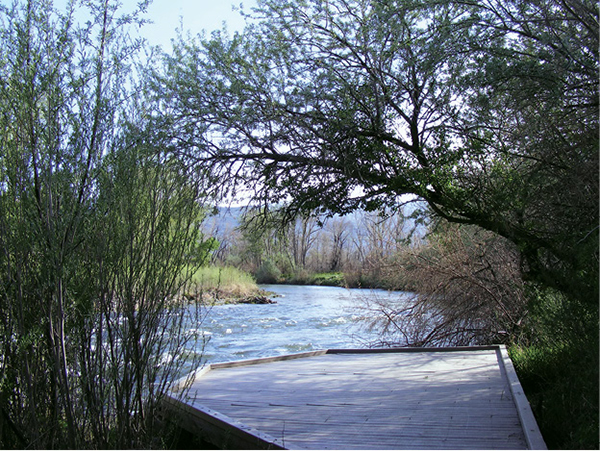
The loop through the Oxbow Nature Study Area allows hikers to explore a pocket of urban wildland.
36
Oxbow Nature Study Area Loop
A nearly pristine pocket of riparian wildland has been set aside along the Truckee River within Reno’s city limits. The nature trail that winds through this tiny preserve bears witness to how nature recovers after fire and flood.
Start: At the signed trailhead adjacent to the Oxbow interpretive center
Distance: 1-mile lollipop
Hiking time: 45 minutes to 1 hour
Difficulty: Easy
Trail surface: Wide gravel and dirt trail; boardwalk
Best seasons: Year-round
Other trail users: None
Canine compatibility: Dogs not permitted
Fees and permits: None
Schedule: Gates open at 8 a.m. daily. In winter the park closes at 4 p.m.; in summer it closes at sunset. During spring, summer, and fall the interpretive center is scheduled to be open from Monday to Friday from 8 a.m. to 5 p.m., but, according to land managers, there are no guarantees.
Trailhead amenities: Limited parking, restrooms, water, picnic facilities, an interpretive center
Maps: USGS Reno NV; no map is necessary
Trail contact: City of Reno Parks, Recreation, and Community Services Department, 190 East Liberty St., Reno, NV 89501; (775) 334-2260; www.cityofreno.com. Nevada Department of Wildlife (NDOW), 1100 Valley Rd., Reno, NV 89512; (775) 334-3808; www.ndow.org. The contact number for school groups is (775) 334-3808.
Finding the trailhead: From I-80 just west of downtown Reno, take the Keystone Avenue exit. Go left (south) on Keystone Avenue for 0.5 mile to West Second Street. Go right (west) on West Second Street for 0.4 mile; it turns into Dickerson Road. Continue another 0.6 mile to the end of Dickerson Road at the park gate. GPS: N39 31.117' / W119 50.774'
The Hike
Restoration and evolution are tangible in the Oxbow Nature Study Area. Its setting is distractingly urban, with railroad tracks running down one side of the preserve and apartment buildings visible through the trees and brush along the riverside on the other. But within the natural area itself you are insulated by greenery, birdsong, and the soothing rumble of the Truckee River rushing over its rocky bed. And if you return year-after-year, you can watch the land heal itself.
Oxbow has been in a state of transition since a human-caused fire burned about eighteen of the park’s twenty-two acres in April 2008, killing some of the old cottonwoods that had thrived in the dense riparian zone and destroying man-made aids to study including a boardwalk and interpretive signs. A new loop trail and fledgling plantings were in place by spring of the following year, and the ravages of the blaze were softened even then by the vibrant greens of new growth. Recovery is a process best appreciated over time, and locals who keep Oxbow in their back pockets will witness the restorative process as it proceeds.
Fire isn’t the only natural force that has transformed Oxbow since it was established in 1991. In 1997, the Truckee overflowed its banks—not for the first time and not for the last—filling the parcel with boulders, sand, and other debris. Nearly 5 feet of sand was deposited in the park during that event.

The loop through the Oxbow Nature Study Area allows hikers to explore a pocket of urban wildland.
But unless your visit coincides with another episode in the Oxbow drama, the study area is a rejuvenating place. Though charred snags can be spied throughout, willows thrive along the riverbanks. Sparrows, woodpeckers, robins, and other songbirds flit and chit in the brush. If you pass quietly and softly, you’re likely to see other woodland creatures as well, and you might be treated to a rarer sighting of deer or coyote, a mink or a muskrat.
Begin your tour by reading the interpretive signs at the trailhead and checking out the viewing platforms. Stairs lead up to an overlook of the Truckee and the small pond that borders it. There is also a short trail that leads right (west) to the pond, which is frequented by ducks and also occasionally hosts a heron or muskrat. Beyond the small picnic green to the left (east) of the park’s information building, another boardwalk leads out onto the Truckee itself, willows crowding the edges of the cold, rumbling water.
The trail proper begins at the base of the elevated viewing platform. You’ll quickly enter the burn zone, and the Truckee comes into view to the left (south). The brush is thin enough to see the urban borders of the greenbelt, the railroad on one side and apartments across the river.
When the trail splits to form a loop, head to the right (northwest) to travel in a counterclockwise circuit. The path winds through recovering grasslands and woodland. Meet the wide gravel trail (the return path) at a T junction and walk a bit farther right (west) to explore a small meadow at the park’s boundary. Then follow the gravel trail back toward the trailhead. Pass a bench and interpretive sign before tracing the shoreline of the Truckee back to the first trail junction. Short side trails head riverside, where you might find a pocket of beach upon which to rest and contemplate the river. From the trail split, retrace your steps to the trailhead.

Miles and Directions
0.0Start by visiting the viewing platforms and pond, then set off down the signed main trail.
0.3Go right (northwest) on the fenced trail through the meadow.
0.5Meet a wide gravel path (the return route). Go right (west) into the meadow at the park’s edge, then return to the trail junction and go right, following the gravel track.
0.75Reach the first trail junction; stay right (straight) to retrace your steps to the trailhead.
1.0Arrive back at the trailhead.
Hike Information
Local information: The Chamber, serving Reno, Sparks, and northern Nevada, offers information and links to community events, government, and businesses including restaurants and lodging. The Reno office is at 449 S. Virginia St. 2nd Floor, Reno, NV 89501; (775) 636-9550; www.thechambernv.org. For information about the city of Reno, call Reno Direct at (775) 334-INFO, or visit www.reno.gov/index.aspx?page=1.

Viewing platforms in the Oxbow Nature Study Area overlook the Truckee River.
Green Tip:
If you see someone else littering, muster up the courage to ask them not to.